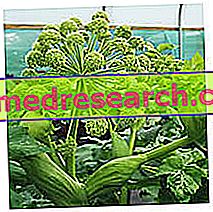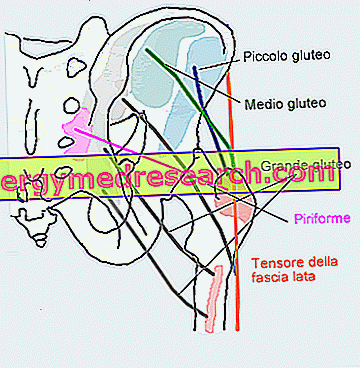
Scientific name
Angelica archangelica L.
Family
Apiaceae (Umbelliferae)Origin
Angelica is native to North America and the central and northern regions of Europe. It is a woodland plant but rarely spontaneous.
Used Parts
Angelica uses fruits and roots, harvested when the plant is 2 years old.Chemical constituents of Angelica
- Essential oil (betafellandrene, pinene, bisabolene);
- Cumarine (umbelliferone);
- Furanocumarine (bergaptene, arcangelina, arcangelicin, imperatorina, isoimperatorina);
- Flavonoids (arcangelone);
- Caffeic acid derivatives;
- Phytosterols.
Angelica in Herbalist: Property of the Angelica
Angelica exhibits spasmolytic, prokinetic, expectorant, aromatic and carminative properties and activities.
In folk medicine, the officinal angelica tincture is used as an aperitif and digestive.
In the past the angelica was considered a useful plant in depressions and anorexia.
Biological activity
As mentioned, angelica is a plant with spasmolytic, carminative, prokinetic, eupeptic, cholagogic and bittering properties. This means that this plant is able to stimulate the secretion of gastric juices, promote intestinal transit, stimulate bile production and at the same time promote excretion.
All this translates into an increase in appetite and a facilitation of digestive processes.
These properties have been widely confirmed; in fact, the use of this plant has obtained official approval for the treatment of dyspeptic disorders and to combat inappetence.
Furthermore, in in vitro studies, the essential oil of angelica has been shown to have interesting antibacterial and antifungal activities against microorganisms, such as: Clostridium difficile, Clostridium perfringens, Enterococcus faecalis, Eubacterium limosum, Peptostreptococcus anaerobius and Candida albicans .
Other studies conducted on animals have instead highlighted the potential anxiolytic properties of angelica extracts. More in detail, these activities seem to be exercised by the mixture of coumarins contained in the plant, in particular by the imperatorin and by the isoimperatorine.
However, despite the encouraging results obtained from the research conducted so far, before being able to exploit similar applications of angelica in the medical field, in-depth clinical studies are certainly necessary, so as to determine the real therapeutic efficacy even in humans.
Angelica against inappetence and dyspeptic disorders
Thanks to the eupeptic, cholagogue, spasmolytic, prokinetic and carminative properties of angelica, this plant is considered an excellent and valid remedy to promote digestion and to combat inappetence and dyspeptic disorders, such as swelling, sense of fullness and flatulence.
For the treatment of the aforementioned disorders, the plant must be used internally.
As an indication, if the angelica is used in the form of a liquid extract (ratio drug / solvent 1: 1), generally, it is recommended to take about 1-3 grams of product per day.
In the case in which, instead, the angelica is used in the form of dye (ratio drug / solvent 1: 5), the usually recommended daily dose is about 1.5 grams of product.
If the plant is used to promote appetite and digestive processes, it is usually recommended to take the preparations at least 15-30 minutes before meals.
Angelica in folk medicine and homeopathy
In folk medicine, the roots of angelica are used as a mildly rubefacient remedy and for the treatment of a wide variety of disorders, such as loss of appetite, digestive disorders, gastrointestinal cramps, coughs, bronchitis, hepatobiliary disorders and menstrual pain.
Angelica leaves, on the other hand, are used as a diuretic and diaphoretic remedy.
Furthermore, traditional medicine also uses angelica fruits. More in detail, the fruits are used internally in case of disorders of the kidneys and urinary tract, intestinal disorders, respiratory disorders, rheumatism and neuralgia. Furthermore, in the past the angelica fruits were also used as an antimalarial remedy.
Externally, however, folk medicine uses the fruits of the plant in ointments used to combat lice infestations.
Angelica is also used in homeopathic medicine, where it can be found in the form of mother tincture, granules and oral drops. In this context, the plant is used in case of dyspeptic disorders associated with flatulence, abdominal swelling, stomach pain, colic, intestinal cramps, nausea, vomiting and anorexia nervosa.
The dose of homeopathic remedy to be taken may vary from individual to individual, also depending on the type of disorder to be treated and the type of homeopathic preparation and dilution that is intended to be used.
Watch the video
X Watch the video on youtubeSide effects
If used properly, angelica and its preparations should not cause any kind of side effects.
However, inside the plant are contained photosensitizing furanocumarine, which can cause the onset of skin inflammation and sunburn. Therefore, exposure to sunlight and UV rays is not recommended during treatment with angelica or its preparations.
Pharmacological Interactions
- possible enhancement of NSAID or cortisone gastrolesivity;
- caution in association with anticoagulant therapies;
- sum of effects with photosensitizing drugs.
Contraindications
Do not use the angelica or its preparations in case of proven hypersensitivity to one or more components.
Furthermore - due to the abortive and emmenagogue effects that angelica can exert - its use is also contraindicated during pregnancy and lactation.
Angelica - Warnings
The bergaptene present in the plant has carcinogenic activity.
Note
Regarding the Chinese variety of Angelica ( Angelica sinensis ), also called Dong quai or "women's ginseng", an interaction with warfarin has been described, with an increased risk of bleeding. The phenomenon is probably related to the coumarins content of angelica.



